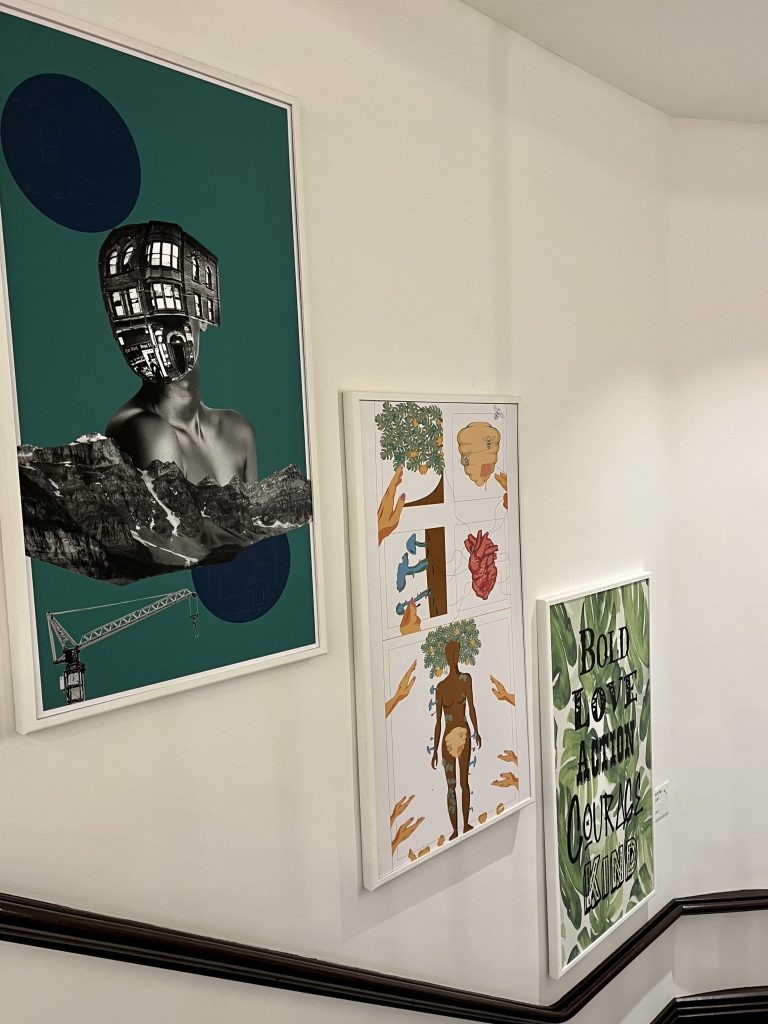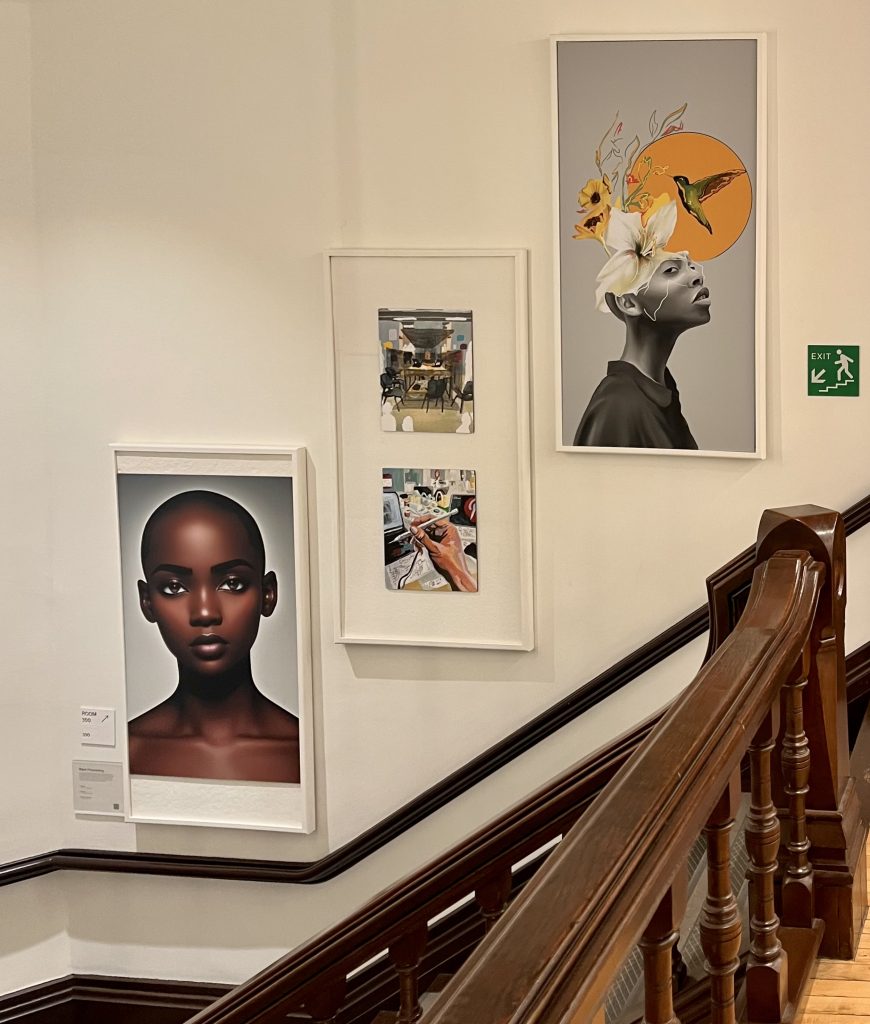

After visiting the art installation “Black Flourishing” at the Daniels Building, Ava reflects on art installations that highlight Black student voices and that inspire new questions, solutions, and ideas for change through art thinking and art activism.
Ava Hawkins, Blog Editor & Digital Content Writer, Honours Bachelor of Science, Cognitive Science & Psychology
The “Black Flourishing” Installation
At the Innovation Hub, equity-centered design drives our work forward by highlighting the many diverse stories and perspectives of the community. Our work is guided by students’ stories, voices, and commitment towards making U of T a better place. Student voices create a sense of unified activism which can look different depending on the place and space – through dialogues, petitions, policies, poems, or art installations.
I’d like to reflect on and learn from engagements with Black art during Black History Month, highlighting how art acts as a catalyst for learning and change. During Black History Month, learning from Black art and artists is one step to understanding different experiences and learning about the importance of amplifying Black student voices.
Back in December, I visited the “Black Flourishing” installation at the John H. Daniels Faculty of Architecture, Landscape, and Design. The installation showcases six student artworks that reflect upon what Black flourishing means and looks like to each artist.
Flourishing can look different for everyone: when I think of the word, I am reminded of personal growth and taking steps to achieve goals. Upon walking up the Daniels staircase, what immediately caught my attention was the diversity of expression and use of various mediums that convey the stories within artwork. In the artworks and artist statements, I saw a celebration of Black culture through values, identity, and representation, with each artist highlighting their own story. Some of the insights I took away from the installation include:
- Change is a shared responsibility – Renée Powell-Hines highlights that both impacted communities and allies must work together to enact honest and meaningful change for the future.
- Capability above appearance – Ally DeLuca and Tomi Bamigbade remind us that race and ethnicity do not hinder a person’s creative capabilities and that people should be seen for who they are.
- Embracing our values – Tamilore Ayeye asks us who we are as we reflect upon our own values and where they bring meaning into our lives, highlighting words such as “Bold, Love, Action, Courage, and Kind.”
Upon reflection, I realized that art is used as more than a portrayal of emotional expression; it communicates messages and experiences that can inspire change.
Art as a Method and Mindset
I realized that while art inspires change, it also inspires a better future. According to the Art Thinking approach, art can act as a medium for shaping an improved society by encouraging new perspectives and curiosity. This approach applies artistic views such as creative questioning and vision modeling, challenging us to rethink and redefine questions that address the root of the issue to go beyond surface-level symptoms.
Art thinking works in tandem with design thinking to produce creative and community-oriented solutions that enable us to go deeper and ask “why?” Art thinking can be a useful tool in cultural and social engagement because it can bring people with multiple viewpoints together to share stories and determine creative solutions that best serve each community.
Art fosters awareness, highlights important issues, and promotes social change. To understand more about art’s impact, I learned about art activism, a practice that combines activist plans and methodologies with art to emotionally engage people and drive social change. I learned that artists can inspire social change by incorporating social justice themes into their artwork, promoting positive change within communities and educating viewers with new perspectives.
Art thinking and art activism allow art to act as a channel for storytelling and problem solving. I hope to apply art thinking to my own work in storytelling as a blog writer by considering multiple viewpoints in my writing and asking questions about topics that seek creative outlooks and angles.
It’s More than Art
For me, art goes beyond the visuals and words on the walls: it is a reminder to build our understanding of the world, and a way to explore the experiences of others. Celebrating and honouring Black History Month can begin with learning about and exploring other people’s stories by viewing Black art through the city or on the campus walls that incite active, deep reflections. For example, I considered questions such as “How can art influence the community to engage with and learn about social issues?” and “What emotions does this art invoke, and what will I do in response to those emotions?”
Black History Month is a reminder for us to reflect and continue our learning every month beyond February. Whether you are a student, staff, faculty, or member of the community, be sure to check out the “Black Flourishing” exhibit before it ends in March. Think about your own experiences, how the artwork makes you feel, and how it can inspire change in your life and the greater community.
Show Support for Black Art and Black History Month Events:
- Visit the “Black Flourishing” Exhibit
- Attend Black History Month Events – Anti-Racism and Cultural Diversity Office
- The Journey: Black Leadership Navigating Institutional Spaces
- There is More: Black Healing Circle
- Learn Black History Month Luncheon
- Explore Nia Centre for the Arts: First Black Arts Centre in Toronto
- Read Poetry and writing by Black authors
- Discover Films and documentaries about Black visual artists
Reference List:
8 must-see documentaries on Black Art. Sothebys.com. (2021, February 19). https://www.sothebys.com/en/articles/8-must-see-documentaries-on-black-art
Black history month. Anti-Racism and Cultural Diversity Office. (n.d.). https://antiracism.utoronto.ca/black-history-month/
Black History Month Luncheon. University of Toronto Alumni. (2024, February 2). https://alumni.utoronto.ca/events-and-programs/black-history-month-luncheon-2023
Black history month – the importance of celebrating Black Art. Rest In Pieces. (n.d.). https://www.restinpieces.co.uk/blogs/news/black-history-month#:~:text=Black%20art%20has%20the%20power,they%20have%20faced%20and%20overcome
Celebrating black poets: Penguin random house. PenguinRandomhouse.com. (n.d.). https://www.penguinrandomhouse.com/the-read-down/celebrating-black-poets/
Cipolle, A. V. (2023, March 6). “taking up space”: Black Designers Focus on Joy in Augsburg exhibition. MPR News. https://www.mprnews.org/story/2023/02/14/taking-up-space-black-designers-focus-on-joy-in-augsburg-exhibition
First Black Arts Centre in Toronto. Nia Centre for the Arts. (2024, January 5). https://niacentre.org/
Lucchinelli, V. (2023, December 4). Creating art for Social Change: How Art Can Inspire activism. Art Sprouts. https://artsproutsart.com/creating-art-for-social-change-how-art-can-inspire-activism/#:~:text=In%20conclusion%2C%20art%20has%20the,positive%20change%20in%20their%20communities.
Ogawa, H. Art thinking research. Ars Electronica Futurelab. (n.d.). https://ars.electronica.art/futurelab/en/research-art-thinking/
The Westport Library Resource Guides: Artistic Activism for Social Change: About. About – Artistic Activism for Social Change – The Westport Library Resource Guides at The Westport Library. (n.d.). https://westportlibrary.libguides.com/ArtActivism#:~:text=Artistic%20Activism%20is%20a%20dynamic,different%20work%20in%20the%20world.
Townsley, J. (2023). Art Thinking and Design Thinking. In: Creativity in Art, Design and Technology. Springer Series on Cultural Computing(). Springer, Cham. https://link.springer.com/chapter/10.1007/978-3-031-24869-6_8#citeas
University of Toronto John H. Daniels Faculty of Architecture, Landscape and Design. (n.d.). Black flourishing: Six student artworks. Daniels. https://www.daniels.utoronto.ca/events/1695182400/black-flourishing-six-student-artworks



0 comments on ““Black Flourishing” Installation: Using Art to Inspire Change ”